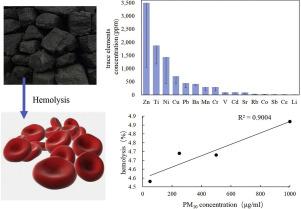Geoscience Frontiers ( IF 8.9 ) Pub Date : 2021-02-23 , DOI: 10.1016/j.gsf.2021.101176 Mengyuan Zhang , Longyi Shao , Tim Jones , Ying Hu , Rachel Adams , Kelly BéruBé

|
Epidemiological studies have suggested that inhalation exposure to indoor ambient air from coal-burning environments is causally associated with respiratory health risks. In order to explore the toxicological mechanisms behind the adverse health effects, the hemolytic activity of PM10 (particulate matter with an aerodynamic diameter of 10um or less) samples collected from homes burning coal in the recognized China “cancer village” Xuanwei were evaluated and matched against their trace elemental contents. The results demonstrated that the hemolytic activity of indoor PM10 in coal-burning environments ranged from 4.28% to 5.24%, with a clear positive dose-response relationship. Although low dose samples exhibited a reduced hemolytic activity, PM10 could have a toxic effect upon people in a coal-burning indoor environment for extended time periods. The concentrations of analyzed trace elements in PM10 samples ranged from 6966 to 12,958 ppm. Among the analyzed elements, Zn, Ti, Ni, Cu, Pb, Ba, Mn, Cr and V were found at higher concentrations and accounted for over 95% of the total elements. The concentrations of total analyzed elements in the PM10 samples revealed a significant positive correlation with PM10 hemolytic activity. Of the analyzed elements, Zn, Pb and Cs positively correlated with hemolysis, while Li, U and V negatively correlated with the hemolysis of human red blood cells (RBCs). Therefore, the heavy metal elements could be one of the main factors responsible for the hemolytic capacity of indoor PM10 in coal-burning environments.


























 京公网安备 11010802027423号
京公网安备 11010802027423号